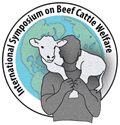Guidelines for Compromised Cattle Transport
Make sure an animal can walk off the trailer before putting in on.
MANHATTAN, Kan. (May 20, 2010) — Jennifer Woods, a livestock handling specialist from Blackie, Alberta, Canada, addressed the topic of animal transport and which animals are fit to travel as she addressed the International Symposium on Beef Cattle Welfare May 20 on the campus of Kansas State University.
Woods said, “The question is not can the animal walk on the trailer? It needs to be ‘Is the animal going to be able to walk off the trailer?’”

"Think ahead to the obstacles the animal will face if it is transported," Jennifer Woods emphasized, adding that some culled animals can be in transit for two weeks before they reach their final destination.
She added, “The transport of compromised animals is one of the most vulnerable issues for our industry because it is so visible.” Woods gave the example of the Westland-Hallmark video showing a downed dairy cow being drug off of a semi-trailer.
“The fact that animals reach this condition and then are shipped is a black eye for the industry, violates consumer trust, can lead to possible prosecution of the individuals involved, and it is wrong,” she said.
Woods shared that Canada has taken a proactive approach to the issue and has a law in place so that compromised animals cannot be transported. Additionally, she shared that in Alberta the livestock industry has developed guidelines and handbooks in the dairy, swine, sheep, beef and equine industries stating whether animals should or should not be shipped.
“These handbooks have given producers tools and have empowered haulers as to what they should or should not haul,” Woods reported, and added that the handbooks have been well-received.
She points out that transportation stressors to animals include handling, mixing, fatigue, environmental, and time off feed and water. “A normal healthy animal can handle these stresses; a compromised animal cannot.”
Among some of the guidelines in the handbook for beef cattle:
• A downer animal that cannot rise or walk cannot be transported.
• An animal with a broken leg cannot be transported.
• Severely lame animals — which means they cannot rise, remain standing or walk — cannot be transported.
• Animals in body condition score (BCS) 1 on a 5-point scale cannot be transported. BCS 2 cattle have a special provision that they can only be hauled a short distance.
• Animals with early stage of cancer eye or respiratory disease can only be hauled a short distance; animals with advanced stage of either of these two diseases cannot be transported.
• Animals with a fever cannot be transported.
• Prolapsed animals can only be transported to the veterinarian.
• Animals that are bloated cannot be transported.
Likewise, there are guidelines for hauling buller steers; horned and polled cattle can’t be mixed unless they’ve previously been socialized; and bulls and cows or cows with calves must be segregated.
“Our producers don’t find these rules restrictive; they recognize these are good management practices,” Woods says.
For producers, she says, “Think ahead to the obstacles the animal will face if it is transported, such as the distance they’ll travel, how long they’ll be on the truck and all the stressors. Maybe you can take an animal by horsetrailer to a local plant instead.”
Bottomline, Woods says, “If you wouldn’t eat the animal, don’t ship it and expect other people to.”
The beef cattle welfare symposium was conducted on campus at K-State University May 19-21. For additional presentation summaries, return to the Meetings > Other Industry Meetings > News Coverage page of the API Virtual Library. For more about the symposium and an archive to the 2008 symposium, visit www.isbcw.beefcattleinstitute.org.
Editor's Note: This article was written under contract or by staff of Angus Productions Inc. (API), which claims copyright to this article. It may not be published or distributed without the express permission of API. To request reprint permission and guidelines, contact Shauna Rose Hermel, editor, at 816-383-5270.

